Page 54 of Never Tear Us Apart
‘Is it a temple? Like the others you’ve shown me?’
‘A temple, yes, a place of burial, and perhaps people lived there alongside the dead, as if they were never really gone. There are three layers, the earliest at the top of the complex, then later chambers were dug deeper into the rock. It’s the only site on Malta where the ochre decorations are still preserved, red spirals painted onto the walls. And then there is the oracle room, a feat of engineering that seems all but impossible considering the tools and knowledge they had.’
‘Why?’ I ask, leaning forwards, intent on finding some answers, any answers.
‘If you sing into an opening in the chamber at exactly the right pitch, your voice can be heard amplified throughout the complex,’ Kathryn explains, ‘perhaps so worship could take place wherever you were. It resonates at one hundred and eleven hertz exactly. They say it’s the frequency of the universe.’
‘Huh.’ I take a long draught of cold Coke and press the glass bottle to the back of my neck. ‘That’s amazing, but I don’t see how it’s connected to what’s happening to me.’
‘I’m still trying to get my head round your haircut,’ Kathryn says, shaking her head. ‘It happened to you in 1942 and to you here, too? It makes no sense.’
‘Don’t think about that,’ I tell her. ‘Just explain what you do know.’
‘The best documented case of vanishing happened in the 1930s.’ Reaching into her bag, she brings out an old copy ofNational Geographicmagazine, its distinctive yellow coverdog-eared and faded. Taking care of the loose pages, she opens to an article and hands it to me.
‘What happened?’ I ask, skimming the article, which seems to be about two young American men on a cycling holiday round Europe.
‘Here.’ She points to the bottom of the article. ‘It reports that at some time in the late 1930s, thirty schoolchildren and their teacher were taken into the hypogeum by a guide and never returned. Then, some months later, they were discovered sleeping in a cave on the other side of the island. They were hospitalised and cared for over years but never regained consciousness. The doctors at the time were baffled. They thought it had to be a kind of sleeping sickness, perhaps from insect bites. When they died, they all died on the same day, within an hour of each other.’
‘So, do you think that this whole group of children – their “souls” maybe – fell into another time, leaving their bodies behind?’
‘I don’t know what I think,’ Kathryn says. ‘I’ve investigated it, searching for more evidence that it happened at all. The article goes on to claim that the cries of the children could be heard from within the caves and tunnels of the island for weeks afterwards, until they just died away . . .’
‘Jesus,’ I say. ‘If what happened to me happened to them, they’d be flung backwards and forwards with no idea what was happening . . .’
‘But there is no other evidence, beyond this article.Ifit happened – and that is a big if – then it’s as if the whole island decided collectively to forget it.’
‘Why would they do that?’ I ask.
‘That’s the question,’ Kathryn says. ‘There are other cases, hardly documented at all. A doctor who appeared on the island during the Napoleonic wars, who knew moreabout advanced medicine than he had any right to. He saved hundreds of lives. When he died, it was discovered that he’d had surgery – top surgery, we call it nowadays – to remove breasts, but his genitalia were still female. That much is documented on his death certificate.’
‘A trans man in the 1800s? There is nothing new under the sun,’ I say.
‘Except that the surgery wasn’t developed until the twentieth century,’ Kathryn says.
‘Oh . . .’
‘And then there is the strange woman of Attard.’
‘Who was she?’
‘She appeared in Attard in the 1980s, wearing a dress that seemed to come from medieval times. She spoke only archaic French and Latin. She was terribly distressed, so she was taken to hospital, but she died on the way there – a heart attack, even though she was probably only in her twenties. No one ever discovered who she was.’
‘Someone with mental health issues?’ I ask tentatively.
‘More than likely. Her clothes were thought to be authentic to the period and got boxed away in the archives of the museum. I tested them a couple of years ago. The threads were at least five hundred years old.’
‘Maybe she found them hanging about in an attic of a palazzo . . .’
‘Yes, that’s probably it.’ Kathryn nods. ‘Except there’s a story of a young woman in the 1500s who was being forced into marriage with the man who raped her. Rather than marry him, she leapt off the top of a tower to her death.’
‘Oh, God! Poor woman!’
‘Yes, poor woman,’ Kathryn says. ‘Except the story goes that she never landed, that she vanished mid-leap. Even though there were dozens of witnesses to her jump, she wasfound in a deep sleep in her bed – a sleep she never awoke from.’
I can’t say I understand, but a slow blurry possibility is starting to form in my mind.
‘So, you were right,’ I say slowly. ‘The stories are true, and it’s something about Malta itself: the people who used to live here, the temples, the hypogeum. The island is a portal. Not always, and not for everyone, but sometimes, some of us find our way through.’















